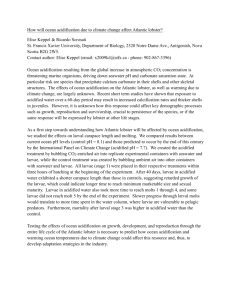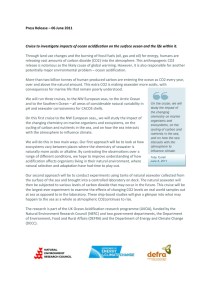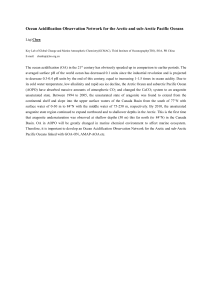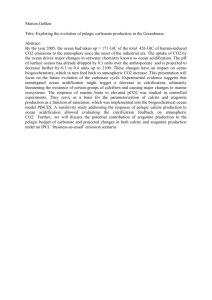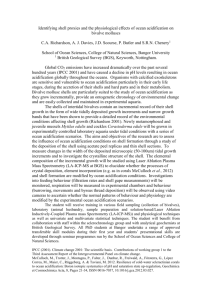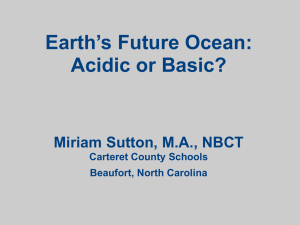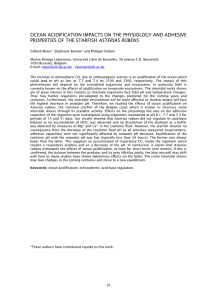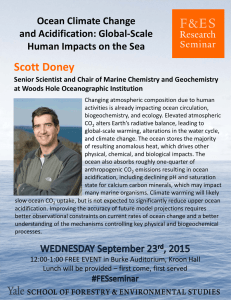Biogeosciences Discussions
advertisement
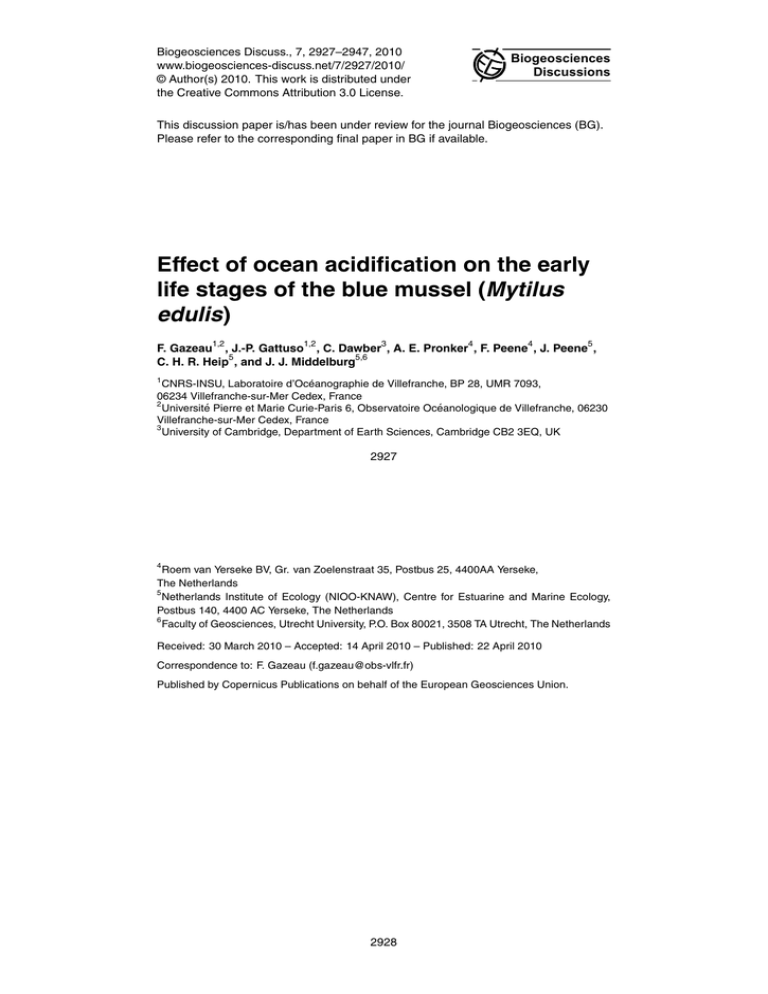
Biogeosciences Discuss., 7, 2927–2947, 2010 www.biogeosciences-discuss.net/7/2927/2010/ © Author(s) 2010. This work is distributed under the Creative Commons Attribution 3.0 License. Biogeosciences Discussions This discussion paper is/has been under review for the journal Biogeosciences (BG). Please refer to the corresponding final paper in BG if available. Effect of ocean acidification on the early life stages of the blue mussel (Mytilus edulis) F. Gazeau1,2 , J.-P. Gattuso1,2 , C. Dawber3 , A. E. Pronker4 , F. Peene4 , J. Peene5 , C. H. R. Heip5 , and J. J. Middelburg5,6 1 CNRS-INSU, Laboratoire d’Océanographie de Villefranche, BP 28, UMR 7093, 06234 Villefranche-sur-Mer Cedex, France 2 Université Pierre et Marie Curie-Paris 6, Observatoire Océanologique de Villefranche, 06230 Villefranche-sur-Mer Cedex, France 3 University of Cambridge, Department of Earth Sciences, Cambridge CB2 3EQ, UK 2927 4 Roem van Yerseke BV, Gr. van Zoelenstraat 35, Postbus 25, 4400AA Yerseke, The Netherlands 5 Netherlands Institute of Ecology (NIOO-KNAW), Centre for Estuarine and Marine Ecology, Postbus 140, 4400 AC Yerseke, The Netherlands 6 Faculty of Geosciences, Utrecht University, P.O. Box 80021, 3508 TA Utrecht, The Netherlands Received: 30 March 2010 – Accepted: 14 April 2010 – Published: 22 April 2010 Correspondence to: F. Gazeau (f.gazeau@obs-vlfr.fr) Published by Copernicus Publications on behalf of the European Geosciences Union. 2928 Abstract 5 10 15 20 Several experiments have shown a decrease of growth and calcification of organisms at decreased pH levels but relatively few studies have focused on early life stages which are believed to be more sensitive to environmental disturbances such as hypercapnia. Here, we present experimental data demonstrating that the growth of planktonic mussel (Mytilus edulis) larvae is significantly affected by a decrease of pH to a level expected for the end of the century. Even though there was no significant effect of a 0.25–0.34 pH unit decrease on hatching and mortality rates during the first 2 days of development nor during the following 13-day period prior to settlement, final shells were, respectively, 4.5±1.3 and 6.0±2.3% smaller at pHNBS ∼7.8 than at a control pHNBS of ∼8.1. Moreover, a decrease of 12.0±5.4% of shell thickness was observed. More severe impacts were found with a decrease of ∼0.5 pHNBS unit during the first 2 days of development which could be attributed to a decrease of calcification due toslight undersaturation of seawater with respect to aragonite. Indeed, important effects on both hatching and D-veliger shell growth were found. Hatching rates were 24±4% lower while D-veliger shells were 12.7±0.9% smaller at pHNBS ∼7.6 than at a control pHNBS of ∼8.1. Although these results show that blue mussel larvae are still able to develop a shell in seawater undersaturated with respect to aragonite, decreases of hatching rates and shell growth suggest a negative impact of ocean acidification on the future survival of bivalve populations potentially leading to significant ecological and economical losses. 1 Introduction 25 The atmospheric partial pressure of CO2 (pCO2 ) will continue to increase beyond the end of this century with projected values ranging from 500 to 1000 µatm, depending on the considered CO2 emission scenario (IPCC, 2007). Because about one third of anthropogenic CO2 emissions (from fossil fuel, cement production and land-use changes) has been stored in the oceans since the industrial revolution (Sabine et al., 2929 5 10 15 20 25 2004), seawater pH has already declined by 0.1 unit compared with pre-industrial values (Orr et al., 2005) and it is projected to decrease by another 0.35 unit by the end of the century (Caldeira and Wickett, 2003). Ocean acidification may have profound impacts on marine biota. Beside the direct effect of decreasing pH on the physiology and metabolism of marine organisms through a disruption of inter-cellular transport mechanisms (see Pörtner et al., 2004, for a comprehensive review), calcareous organisms are particularly sensitive due to the decreasing availability of carbonate ions (CO2− 3 ) driven by increasing pCO2 . Indeed, this generates a decrease of the calcium carbonate saturation state (Ω): h ih i 2− 2+ CO3 Ca , Ω= (1) 0 Ksp 0 where Ksp is the stoichiometric solubility product, which is a function of temperature, salinity, pressure and the mineral phase considered (calcite, aragonite or highmagnesian calcite). Cold waters will become undersaturated with respect to aragonite (Ωaragonite < 1) in few decades (Orr et al., 2005). Since the seminal paper of Broecker and Takahashi (1966) reporting a dependency of calcification rates on CaCO3 saturation state, several experimental studies have investigated the effect of a pCO2 increase on the growth of calcifying organisms. Most studies have investigated primary producers (corals, coralline algae and coccolithophores) and have shown a very large range of responses (Feely et al., 2004; Kleypas et al., 2006; Doney et al., 2009). Among calcifying species, molluscans are very important both in ecological and economical terms. Shellfish are ecosystem engineers governing energy and nutrient flows in coastal ecosystems, providing habitats for many benthic organisms and constitute an important food source for birds (Gutiérrez et al., 2003; Norling and Kautsky, 2007). Moreover, with an average annual increase of 7.7% over the last 30 years, global shellfish aquaculture production reached 13.2 million tons in 2004, corresponding to a commercial value of US$ 9.8 billion (FAO, 2007). The Pacific oyster (Crassostrea gigas) was the most cultivated species in 2004 with a volume of 4.6 million tons or 7.7% of 2930 5 10 15 20 25 the total world aquaculture production while mussel production represented 1.9 million tons. A negative impact of ocean acidification on the growth of these species would, therefore, not only have also major consequences for coastal biodiversity and ecosystem functioning and services, but will also cause a significant economic loss (Gazeau et al., 2007; Cooley and Doney, 2009). Several studies have focused on the effect of projected pH levels on the growth of benthic (e.g. Gazeau et al., 2007; Ries et al., 2009) and planktonic (e.g. Comeau et al., 2009) molluscs. Most of these studies have demonstrated a negative effect of ocean acidification on the growth of these organisms although recent experiments (Ries et al., 2009) have suggested a more complicated story with species-specific sensitivities to decreasing pH levels and positive effects on calcification rates in some cases. Most studies have investigated adult stages whereas the early life stages of calcifying organisms are generally considered to be more sensitive to environmental disturbances (Raven et al., 2005). Moreover, amorphous calcium carbonate (AAC) and aragonite have been identified as the main CaCO3 mineralization form in Molluscs larval stages (Medakovic, 2000). Therefore, as aragonite is 50% more soluble than calcite, these aragonitic larval stages are expected to be more sensitive to ocean acidification than calcitic organisms. Indeed, several recent studies have focused on the effect of ocean acidification on the early development of mollusc species (Kurihara et al., 2007, 2009; Ellis et al., 2009; Miller et al., 2009; Parker et al., 2009; Talmage and Gobler, 2009) and most of them have reported negative impacts of decreasing pH levels on the growth and development of these organisms. So far, there have been no studies on the effect of ocean acidification on the larval development of the blue mussel (Mytilus edulis), the second most cultivated bivalve species after Crassostrea gigas. This study aims to investigate the effects of future ocean pH levels on the development of these organisms. 2931 2 Material and methods 2.1 5 10 15 To investigate the effect of rising atmospheric CO2 on mussel (Mytilus edulis) larvae, experiments were carried out in mesocosms at the commercial hatchery Roem van Yerseke (Yerseke, The Netherlands) between 18 October and 27 November 2007. A group of approximately 150 ripe, rope-cultured mussels from the Oosterschelde, a tidal ◦ inlet, were kept at a constant temperature (10 C) for about 4 months. Before spawning, mussels (male and female) were cleaned with 1 µm filtered seawater and placed in a spawning tank. Mass spawning was initiated by rapidly raising water temperature from 10 ◦ C to 19 ◦ C. Fertilized eggs were retained on a submerged 30 µm sieve. During each experiment (see below), six enclosures were used, each of them containing 130 l of filtered (1 µm) seawater from the Oosterschelde. Three enclosures were continuously bubbled with ambient air (pCO2 ∼ 380 µatm) while the three others were bubbled with a mixture of ambient air and pure CO2 . The flow rates of CO2 were regulated by means of digital thermal mass flow controllers in order to reach the desired seawater pH. 2.2 20 25 Test animals and experimental conditions Bioassay In a first experiment (experiment #1), the effects of a pH decrease from ∼8.1 (control) to, successively, ∼7.8 and ∼7.6 were investigated during the first two days of development (from eggs to D-shape larvae). After fertilization (see above), embryos were counted, divided into 6 groups and transferred to the enclosures (3 controls, 3 low pH) −1 at a density of approximately 10 embryos ml . Embryos were maintained in batch conditions (no feeding, no water flowing) until the population reached the D-veliger stage (initial development of the shell, reached in about 2 days). In a second experiment (experiment #2), larvae were exposed to pH values of ∼8.1 and ∼7.8 during the two weeks development period following the D-veliger stage. Embryos were grown at environmental pH (∼8.0–8.1) during 2 days, then counted and 2932 5 10 15 20 25 5 10 evenly transferred to the 6 enclosures (3 controls, 3 low pH) at a density of approximately 10 embryos ml−1 . Cultivation period lasted for 13 days (day 2 to day 15 of development) until the population reaches the pediveliger stage. Larvae were fed in a continuous flow-through system with a mixture of Isochrysis sp. (T-Iso, CCAP 927/14) and Chaetoceros muellerii (CCMP 1332) (2:1, based on cell counts) at a concen−1 tration of approximately 80 000 cells ml . From day 4 to the end of the experiment, larvae were fed with a mixture of Isochrysis sp., Pavlova lutherii (CCAP 931/1) and Chaetoceros muellerii (2:1:2, based on cell counts) at a concentration of approximately −1 150 000 cells ml . 2.3 At the end of experiment #1 (day 2) and three times a week during experiment #2, the enclosures were emptied and cleaned with a mixture of diluted acetic acid and HCl. Water from the tanks was passed through a 90 µm sieve and larvae were concentrated in 2-l jars. A sub-sample of 50 ml was fixed in a 5% neutralized-formalin seawater solution to determine the larval abundance, hatching rates (% of D-veliger larvae) and size. After sampling during experiment #2, we made sure that pH was constant and at the desired pH level before reintroducing the larvae in the enclosures. Larval abundance was estimated based on triplicate counting of 500 µl sub-samples, under a binocular microscope. Larvae shell length (measured on 100 individuals) was measured (anterior to posterior dimension of the shell parallel to the hinge) under a microscope (20×; 0.01 µm precision in length measurement). Shell thickness was estimated from scanning electron micrograph (SEM) images acquired using the JEOL JSE 820 microscope at Cambridge University. Dried larval shells were mounted onto double sided carbon tape and sectioned using a flat edge needle. Loose organic matter and residual shell were removed with a dry paintbrush. Larval shells were removed using a wet paintbrush, reoriented and remounted onto fresh tape attached to aluminium stubs and gold coated. Shell thickness was determined on 20 individuals of each replicate treatment. Hatching rates were defined as the percentage of “normal” 2933 D-shape larvae following the criteria proposed by His et al. (1997), after observation of a minimum of 500 larvae. During the two experiments, pH, temperature and oxygen concentrations were continuously monitored in each enclosure using Metrohm and Consort electrodes, which were calibrated daily on the N. B. S. scale for pH (pH 4 and 7). Salinity was measured at the beginning of each incubation periods (3) in each enclosure. Daily measurements of total alkalinity (TA) in the 6 enclosures were performed by Gran electro-titration on 50 ml samples filtered on GF/F membranes. Titrations of TA standard provided by A. G. Dick−1 −1 son (batch 82) were within 0.22 µeq kg of the nominal value (2334.8±3.3 µeq kg ; n=5). pCO2 was computed from pHNBS and TA using the software package CO2 (M. Frankignoulle) and the thermodynamic constants of Mehrbach et al. (1973). The solubility products for calcite and aragonite were from Morse et al. (1980). 2.4 15 20 25 Sampling and analytical measurements Statistical analysis For final shell length (experiment #1 and #2) and shell thickness (only experiment #2), differences between replicates of each treatment as well as between control and low pHNBS treatments were tested using one-way ANOVA after testing for normality (Kolmogorov-Smirnof test). No significant differences were found in any of these parameters between the replicate tanks within each experimental condition. For hatching rates and abundances, as only one value was estimated per replicate, this latter was used to obtain grand means and standard deviations (SD) values for each treatment. Since normality tests could not be applied due to the small sample size, differences of hatching rates between control and low pHNBS conditions were tested by means of unpaired Student’s t-tests using a Welch correction that does not assume equal variance between the two groups (Graphpad Instat software). For all tests, differences were considered significant at p < 0.05. In the following section, data are presented as means±SD. 2934 3 Results 5 10 15 20 25 The environmental parameters as well as parameters of the carbonate chemistry are shown in Table 1. During experiment #1, pHNBS was maintained, during the first set of incubations, at 8.15±0.01 (Control-1) and 7.81±0.01 (Low pH-1) corresponding to pCO2 values of 468 and 1124 µatm, while during the second set of incubations, larvae were kept at pHNBS 8.09±0.01 (Control-2) and 7.58±0.01 (Low pH −2), corresponding to pCO2 values of 537 and 1929 µatm. During experiment #2, seawater pHNBS was maintained at 8.03±0.03 (Control, pCO2 =642 µatm) and 7.78±0.05 (Low pH, pCO2 =1213 µatm). Results obtained during these 2 experiments are presented in Figs. 1, 2 and 3. Data used for these figures as well as environmental parameters (pHNBS , TA and temperature) measured at the time of sampling are presented in Appendix 1 (available as Supplementary Material at http://www.biogeosciences-discuss. net/7/2927/2010/bgd-7-2927-2010-supplement.pdf). In the Oosterschelde tidal inlet (5 stations, monthly measurements), surface pHNBS varies annually between 8.00 and −1 8.24, while TA varies between 2.334 and 2.567 meq kg (data not shown). In the fall (that is the time of the experimental period), pHNBS and TA in the tidal inlet are, on average, 8.04 and 2.436 meq kg−1 , respectively. Significantly higher pHNBS values have been obtained for the control tanks in our experiments due to the continuous bubbling with external air (∼380 µatm), especially during experiment #1 which was performed in batch conditions. During experiment #2, the continuous flow-through system did not allow such an efficient equilibration with air, leading to significantly lower pHNBS values (8.03±0.03), closer to environmental levels. It must be stressed that the pCO2 levels for low-pHNBS treatments were slightly outside the range projected for the end of the century (500–1000 µatm) and must be considered as extreme conditions. The objective of the experiment was to test the effect of a ∼0.3 pHNBS unit decrease of these organisms and, in that sense, experimental conditions were successfully set up and controlled. 2935 5 10 15 During experiment #1, a seawater pHNBS decrease of 0.34 unit (pHNBS =7.81; Ωaragonite =1.38) had a significant effect on mussel larvae development (Fig. 1). Although no significant effect was found on hatching rates (unpaired Student’s t-test, p > 0.05), the average shell lengths at the end of the 2-day incubation period at pHNBS 7.81 were significantly lower (ANOVA, n=100, p < 0.001) than at higher pHNBS . The relative decrease in shell length after 2 days has been estimated to 4.5±1.3%. In contrast, a decrease of 0.51 unit (pHNBS =7.58; Ωaragonite =0.81) had large effects on both the hatching and growth rates. The hatching rates decreased by 24±4% (unpaired Student’s t-test, p < 0.001), while D-veliger shells were 12.7±0.9% smaller (ANOVA, n=100, p < 0.001). From day 2 to day 15 (experiment #2, Figs. 2 and 3), a decrease of seawater pHNBS by 0.25 (pHNBS =7.78; Ωaragonite =1.37) also did not have significant effects on larvae survivorship (unpaired Student’s t-test, n=3, p > 0.05) while a significant effect was found for final shell length (ANOVA, n=100, p < 0.001), corresponding to a relative decrease of 6.0±2.3%. Effects on final shell thickness were more important with a significant (ANOVA, n=20, p < 0.001) relative decrease of 12.0±5.4%. 4 Discussion 20 25 In the past few years, several papers have reported on the impacts of seawater acidification on the growth and development of shellfish early life stages. Kurihara et al. (2007, 2008) have demonstrated that a pHNBS decrease to ∼7.4 caused a significant alteration of Crassostrea gigas and Mytilus galloprovincialis early (up to 6 d) larval development. It has to be noted that at this pH level, which is much lower than the levels projected for the end of the century, the seawater was clearly undersaturated with respect to aragonite (∼0.68). Parker et al. (2009) studied the synergistic effects of ocean acidification and temperature on the fertilization and early (up to 48 h) embryonic development of the Sydney rock oyster (Saccostrea glomerata). These authors found that both fertilization and embryonic development were altered at lowered pH values in the range of projected levels for 2100 while temperature revealed an optimal level (26 ◦ C) 2936 5 10 15 20 25 below and above which both of these processes were diminished. Talmage and Gobler (2009) performed a multi-species comparison of the effects of ocean acidification on growth and metamorphosis (from 4 to 18 days of development). They actually showed that, although the growth of the 3 studied species (Mercenaria mercenaria, Argopecten irradians, and Crassostrea virginica) was negatively affected, they did not exhibit the same sensitivity to a decrease of up to 0.6 pH unit. This species-specific sensitivity to ocean acidification has also been observed by Miller et al. (2009) who showed that the development (from 96 h to ∼30 d) and growth of the Eastern oyster (Crassostrea virginica) was significantly reduced at lowered pH levels (up to a 0.4 pHNBS unit decrease), while the Suminoe oyster (Crassostrea ariakensis) did not appear to be sensitive to the same acidified conditions. In this study, we show that ocean acidification has a significant effect on the blue mussel larval development although the observed decrease in growth rates both in terms of length and thickness was not accompanied by a decrease of hatching rates and an increase in mortality rates as long as seawater remained oversaturated with respect to aragonite. Although no effect on hatching and mortality rates have been observed after 2 d and after 15 d of development, the consequences, in the field with the presence of predators, of a potential decrease of shell resistance due to a reduction in growth as observed for a 0.25–0.34 pH unit decrease, are still unknown. At pHNBS ∼ 7.6, both hatching success and growth rates (as estimated by shell length decrease after 2 d of development) exhibited an important decrease coinciding with a slight undersaturation of seawater with respect to aragonite. It is important to notice that even under aragonite undersaturated conditions, mussel larvae were able to produce a shell, highlighting that molluscs exert a control over calcification (McConnaughey and Gillikin, 2008) and are therefore not completely dependent on environmental conditions. This does not appear as a surprise since most freshwater molluscs are clearly well adapted to such conditions (Miller et al., 2009) and bivalve growth has been showed by Tunnicliffe et al. (2009) under the extremely undersaturated conditions of deep hydrothermal sites. Most calcifying species, including molluscs, are able to concentrate Ca2+ and CO2− 3 2937 5 10 15 20 25 ions at the site of calcification. However, as this mechanism, obviously requires energy, this can lead to substantial energy shifts from other processes and to important costs for the growth of the organism as observed by Wood et al. (2008) for the brittlestar Amphiura filiformis. At this point, it can only be speculated that the observed decrease in larval developmental success for a ∼0.5 pHNBS unit decrease is due to the seawater undersaturation with respect to aragonite. It must be stressed that our data do not allow discriminating between the physiological impact of pH decrease alone via a disruption of inter-cellular transport mechanisms and the impact on calcification resulting from aragonite undersaturation, on the larval development of this species. More studies are needed to disentangle these different aspects of the potential effect of ocean acidification on marine organisms. As the different pressures exerted by the environment and predators in the field result in a considerable mortality, approaching 99% (Bayne, 1976) during the free-swimming larval period, an additional 24% decrease in hatching rates as observed at a pHNBS of 7.6 can therefore compromise the survival of the population. Indeed, relatively small fluctuations in the abundance of these larval stages are known to regulate the size of the population (Green et al., 2004). Shellfish predominantly inhabit coastal regions, which usually exhibit lower pH values than the open ocean because of permanent or episodic low pH water inputs from rivers (Salisbury et al., 2008). While many estuaries already have high and variable pCO2 , atmospheric CO2 enrichment will shift the baseline toward even higher values (Miller et al., 2009) that could lead to extended periods of undersaturation with respect to aragonite. Therefore, these species will undoubtedly be exposed to suboptimal growth conditions in the coming years. In order to assess socio-economic and ecological effects of ocean acidification on shellfish, it is therefore crucial to predict accurately the evolution of pH as well as the saturation state of the ocean and its coastal waters with respect to aragonite in the near future. Our observation of no significant effect of a ∼0.3 pHNBS unit decrease on both hatching rates and survivorship stands in contrast with results obtained by Parker et 2938 5 10 15 20 25 al. (2009) on Saccostrea glomerata during the first 48h of development and by Talmage et al. (2009) on Mercenaria Mercenaria and Argopecten irradians between the veliger and metamorphosed stages (18–20 days). Our results are consistent with those from Talmage et al. (2009) on Crassostrea virginica who observed significant effects on growth rates but no significant effects on survivorship for a ∼0.3 pH unit decrease. Altogether, these different studies reveal, as what is observed for adult stages, that the effects of ocean acidification of molluscans early life development are species-specific (Kurihara, 2008) and that the sensitivity of the organisms might depend on the pH variability at which they are naturally exposed in the field. In the present study, we show that shell increase, by linear extension, which is the most commonly measured parameter in ocean acidification related studies for molluscs larvae, should not be the only measured parameter if one wants to investigate the effects of acidification on shell growth. Indeed, shell thickness appeared to be affected as well with a relative decrease twice the relative decrease observed in shell length. This is consistent with Miller et al. (2009) findings who estimated a much higher decrease of shell weight (estimated as the amount of calcium in the shells) than shell area (respectively −42 and −16% between pre-industrial and end of 21st century projected pH level for C. virginica). However, it must be stressed that, in our study, shell thickness measurements could not be performed on D-veliger (2 days old) larvae and appeared to be limited to large pediveliger larvae using our protocol. Calcium content in the shells, as an estimator of shell weight, is also an interesting parameter to follow and has been successfully applied by Miller et al. (2009). However, again, this technique has been applied to large metamorphosed larvae, and there is still a need to test its validity for smaller veliger larvae. Finally, more precise techniques such as 45 Ca labelling, recently used on pteropods (planktonic molluscs; Comeau et al., 2009) are promising and might be valuable tools to accurately evaluate the effect of ocean acidification within the range of expected levels for 2100 on calcification rates of mollusc early life stages. 2939 Acknowledgements. This research has received support from the Netherlands Organization of Scientific Research and is a contribution to the ”European Project on Ocean Acidification” (EPOCA) which received funding from the European Community’s Seventh Framework Programme (FP7/2007-2013) under grant agreement no. 211384. 5 The publication of this article is financed by CNRS-INSU. References 10 15 20 Bayne, B. L.: Marine mussels: their ecology and physiology, International Biological Programme 10, Cambridge University Press, Cambridge, 506 pp., 1976. Broecker, W. S. and Takahashi, T.: Calcium carbonate precipitation on the Bahama Banks, J. Geophys. Res., 71, 1575–1602, 1966. Caldeira, K. and Wickett, M. E.: Anthropogenic carbon and ocean pH, Nature, 425, 365–365, 2003. Comeau, S., Gorsky, G., Jeffree, R., Teyssié, J.-L., and Gattuso, J.-P.: Impact of ocean acidification on a key Arctic pelagic mollusc (Limacina helicina), Biogeosciences, 6, 1877–1882, 2009, http://www.biogeosciences.net/6/1877/2009/. Cooley, S. R. and Doney, S. C.: Anticipating ocean acidification’s economic consequences for commercial fisheries, Environ. Res. Lett., 4(8), 024007, doi:10.1088/1748-9326/4/2/024007, 2009. Doney, S. C., Fabry, V. J., Feely, R. A., and Kleypas, J. A.: Ocean acidification: the other CO2 problem, Ann. Rev. Mar. Sci., 1, 169–192, 2009. Ellis, R. P., Bersey, J., Rundle, S. D., Hall-Spencer, J. M., and Spicer, J. I.: Subtle but significant 2940 5 10 15 20 25 30 effects of CO2 acidified seawater on embryos of the intertidal snail, Littorina obtusata, Aquat. Biol., 5, 41–48, doi:10.3354/ab00118, 2009. FAO: Food and Agriculture Organization, Fisheries Department, The State of World Fisheries and Aquaculture, Rome, 2007. Feely, R. A., Sabine, C. L., Lee, K., Berelson, W., Kleypas, J., Fabry, V. J., and Millero, F. J.: Impact of anthropogenic CO2 on the CaCO3 system in the oceans, Science, 305, 362–366, 2004. Gazeau, F., Quiblier, C., Jansen, J. M., Gattuso, J.-P., Middelburg, J. J., and Heip, C. H. R.: Impact of elevated CO2 on shellfish calcification, Geophys. Res. Lett., 34, L07603, doi:10.1029/2006GL028554, 2007. Green, M. A., Jones, M. E., Boudreau, C. L., Moore, R. L., and Westman, B. A.: Dissolution mortality of juvenile bivalves in coastal marine deposits, Limnol. Oceanogr., 49, 727–734, 2004. Gutiérrez, J. L., Jones, C. G., Strayer, D. L., and Iribarne, O. O.: Mollusks as ecosystem engineers: the role of shell production in aquatic habitats, Oikos, 101, 79–90, 2003. His, E., Seaman, M. N. L., and Beiras, R.: A simplification of the bivalve embryogenesis and larval development bioassay method for water quality assessment, Water Res., 31, 351–355, 1997. IPCC: Climate Change 2007: The Physical Science Basis. Contribution of Working Group I to the Fourth Assessment. Report of the Intergovernmental Panel on Climate Change., edited by: Solomon, S., Qin, D., Manning, M., Chen, Z., Marquis, M., Averyt, K. B., Tignor, M., and Miller, H. L., Cambridge University Press, Cambridge, United Kingdom and New York, NY, USA, 996 pp., 2007. Kleypas, J. A., Feely, R. A., Fabry, V. J., Langdon, C., Sabine, C. L., and Robbins, L. L.: Impacts of ocean acidification on coral reefs and other marine calcifiers: A guide for future research, Report on the workshop held 18–20 April 2005, St. Petersburg, FL, sponsored by NSF, NOAA and the US Geological Survey, 88 pp., 2006. Kurihara, H., Kato, S., and Ishimatsu, A.: Effects of increased seawater CO2 on early development of the oyster Crassostrea gigas, Aquat. Biol., 1, 91–98, 2007. Kurihara, H.: Effects of CO2 -driven ocean acidification on the early developmental stages of invertebrates, Mar. Ecol. Prog. Ser., 373, 275–284, 10.3354/meps07802, 2008. Kurihara, H., Asai, T., Kato, S., and Ishimatsu, A.: Effects of elevated pCO2 on early development in the mussel Mytilus galloprovincialis, Aquat. Biol., 4, 225–233, doi:10.3354/ab00109, 2941 5 10 15 20 25 30 2008. Kurihara, H., Asai, T., Kato, S., and Ishimatsu, A.: Effects of elevated pCO2 on early development in the mussel Mytilus galloprovincialis, Aquat. Biol., 4, 225–233, doi:10.3354/ab00109, 2009. McConnaughey, T. A. and Gillikin, D. P.: Carbon isotopes in mollusk shell carbonates, GeoMarine Lett., 28, 287–299, doi:10.1007/s00367-008-0116-4, 2008. Medakovic, D.: Carbonic anhydrase activity and biomineralization process in embryos, larvae and adult blue mussels Mytilus edulis L, Helgoland Marine Res., 54, 1–6, 2000. Mehrbach, C., Culberson, C. H., Hawley, J. E., and Pytkowicz, R. M.: Measurement of the apparent dissociation constants of carbonic acid in seawater at atmospheric pressure, Limnol. Oceanogr., 18, 897–907, 1973. Miller, A. W., Reynolds, A. C., Sobrino, C., and Riedel, G. F.: Shellfish face uncertain future in high CO2 world: Influence of acidification on oyster larvae calcification and growth in estuaries, PLoS ONE, 4, e5661, doi:10.1371/journal.pone.0005661, 2009. Morse, J. W., Mucci, A., and Millero, F. S.: The solubility of calcite and aragonite in seawater of 35‰ salinity and atmospheric pressure, Geochim. Cosmochim. Acta, 44, 85–94, 1980. Norling, P. and Kautsky, N.: Structural and functional effects of Mytilus edulis on diversity of associated species and ecosystem functionning, Mar. Ecol. Prog. Ser., 351, 163–175, 2007. Orr, J. C., Fabry, V. J., Aumont, O., Bopp, L., Doney, S. C., Feely, R. A., Gnanadesikan, A., Gruber, N., Ishida, A., Joos, F., Key, R. M., Lindsay, K., Maier-Reimer, E., Matear, R., Monfray, P., Mouchet, A., Najjar, R. G., Plattner, G. K., Rodgers, K. B., Sabine, C. L., Sarmiento, J. L., Schlitzer, R., Slater, R. D., Totterdell, I. J., Weirig, M. F., Yamanaka, Y., and Yool, A.: Anthropogenic ocean acidification over the twenty-first century and its impact on calcifying organisms, Nature, 437, 681–686, 2005. Parker, L. M., Ross, P. M., and O’Connor, W. A.: The effect of ocean acidification and temperature on the fertilization and embryonic development of the Sydney rock oyster Saccostrea glomerata (Gould 1850), Global Change Biol., 15, 2123–2136, doi:10.1111/j.13652486.2009.01895.x, 2009. Pörtner, H. O., Langenbuch, M., and Reipschlager, A.: Biological impact of elevated ocean CO2 concentrations: Lessons from animal physiology and earth history, J. Oceanogr., 60, 705–718, 2004. Raven, J., Caldeira, K., Elderfield, H., Hoegh-Guldberg, O., Liss, P., Riebesell, U., Shepherd, J., Turley, C., and Watson, A.: Ocean acidification due to increasing atmospheric carbon 2942 5 10 15 dioxide. The Royal Society policy document 12/05, The Cloyvedon Press, Cardiff, 58 pp., 2005. Ries, J. B., Cohen, A. L., and McCorkle, D. C.: Marine calcifiers exhibit mixed responses to CO2 -induced ocean acidification, Geology, 37, 1131–1134, doi:10.1130/g30210a.1, 2009. Sabine, C. L., Feely, R. A., Gruber, N., Key, R. M., Lee, K., Bullister, J. L., Wanninkhof, R., Wong, C. S., Wallace, D. W. R., Tilbrook, B., Millero, F. J., Peng, T. H., Kozyr, A., Ono, T., and Rios, A. F.: The oceanic sink for anthropogenic CO2 , Science, 305, 367–371, 2004. Salisbury, J., Green, M., Hunt, C., and Campbell, J.: Coastal acidification by rivers: a new threat to shellfish?, Eos Trans AGU, 89, 513, 2008. Talmage, S. C. and Gobler, C. J.: The effects of elevated carbon dioxide concentrations on the metamorphosis, size, and survival of larval hard clams (Mercenaria mercenaria), bay scallops (Argopecten irradians), and Eastern oysters (Crassostrea virginica), Limnol. Oceanogr., 54, 2072–2080, 2009. Tunnicliffe, V., Davies, K. T. A., Butterfield, D. A., Embley, R. W., Rose, J. M., and Chadwick, W. W.: Survival of mussels in extremely acidic waters on a submarine volcano, Nature Geosci., 2, 344–348, doi:10.1038/ngeo500, 2009. Wood, H. L., Spicer, J. I., and Widdicombe, S.: Ocean acidification may increase calcification rates, but at a cost, Proc. R. Soc. B-Biol. Sci., 275, 1767–1773, doi:10.1098/rspb.2008.0343, 2008. 2943 Table 1. Environmental parameters and carbon chemistry of experimental seawater during the course of the different experiments. pCO2 and related carbonate parameters were computed from mean pHNBS and Total Alkalinity during each incubation. Control-1 Measured parameters Temperature (◦ C) Salinity Oxygen (% of saturation) pHNBS Chlorophyll-a (µg l−1 ) Total alkalinity (meq kg−1 ) Calculated parameters pCO2 (µatm) −1 DIC (mmol kg ) − −1 [HCO3 ] (mmol kg ) −1 [CO2− ] (mmol kg ) 3 Ωaragonite Ωcalcite Experiment #1: day 0 to day 2 Low pH-1 Control-2 Low pH-2 Experiment #2: day 2 to day 15 Control Low pH 16.6±1 32.1±0.1 100±3 8.15±0.01 – 2.486±0.006 16.7±0.8 31.9±0.2 94.7±2.6 7.81±0.01 – 2.483±0.006 16.5±1 32.0±0.1 96.4±2.5 8.09±0.01 – 2.436±0.006 16.2±1.2 32.1±0.1 97.6±0.6 7.58±0.01 – 2.437±0.004 19.5±0.3 31.4±0.3 91.3±6.9 8.03±0.03 29.12±8.87 2.402±0.02 19.2±0.4 31.5±0.1 91.8±4.4 7.78±0.05 31.12±12.55 2.403±0.02 468 2.254 2.071 0.166 2.75 5.12 1124 2.397 2.273 0.084 1.38 2.58 537 2.237 2.073 0.144 2.39 4.45 1929 2.432 2.312 0.049 0.81 1.52 642 2.218 2.062 0.135 2.30 4.27 1213 2.321 2.200 0.080 1.37 2.54 2944 Fig. 1. Proportion of embryos that developed to D-shape larvae (A) and average length of Dshape shell (B) at the end of the two incubation periods during experiment #1, in control (black bars) and low pH (white bars) seawater. During the first incubation, seawater pHNBS was maintained at 8.15±0.01 (Control-1) and at 7.81±0.01 (Low pH-1). During the second incubation, pHNBS levels of 8.09±0.01 and 7.58±0.01 were used (Control-2 and Low pH-2, respectively). Errors bars represent standard deviations of the triplicate enclosures. **Significant difference between control and low-pH groups. 2945 Fig. 2. Abundance (A) and average shell length (B), during experiment #2 (13 days, from Dshape to pediveliger larvae), in control (solid line, black dots) and CO2 (dotted line, white dots) seawater. Seawater pHNBS was maintained at 8.03±0.03 and 7.78±0.05 in control and low pH enclosures, respectively. Errors bars represent standard deviations of the triplicate enclosures. 2946 Fig. 3. Average shell thickness at the end of experiment #2 for larvae on day 15 of development, in control (pHNBS =8.03±0.03; black bars) and low pH (pHNBS =7.78±0.05; white bars) seawater. Errors bars represent standard deviations of the triplicate enclosures. **Significant difference between control and low-pH groups. 2947
